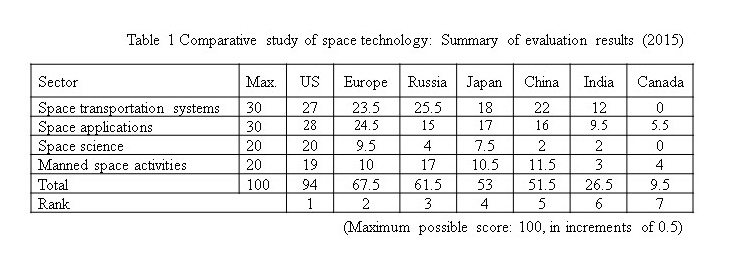(Global Technology Comparison on specific topics)
A Comparative Study on Space Technology in the World (2015)/CRDS-FY2016-CR-02
This is the third G-TeC study of space technology, following previous studies published by JST / CRDS in 2011 and 2013.
In the two years since the previous study, the number of launch and satellite 2014 and 2015 has been summarized for this evaluation. There was a total of 179 rocket launches around the world over these two years, with a total of 472 satellites, including communications broadcasting satellites, earth observation satellites, navigational positioning satellites, astronomical observation satellites and manned spacecraft, placed into orbit by 36 countries and five agencies.
During the 179 launches, there were a total of eight failures, with the failed launch of a Proton launch vehicle by Russia, and an Antares and Falcon launch vehicle by the United States, and three Russian Soyuz launch vehicles that failed to reach orbit.
Satellite launches were generally successful, with 294 communications broadcasting satellites, earth observation satellites and navigational positioning satellites in the field of space application, eight astronomical observation satellites in fields related to astronomical observation, and 26 manned spacecraft and cargo transport vehicles launched in the field of manned space flight. These included 144 engineering test satellites and AIS satellites, with the annual average number of launches over the period exceeding the 28 launches in 2013.
Cargo transportation to the International Space Station (ISS) suffered from the October 2014 launch failure of American Orbital Sciences (current Orbital ATK) Cygnus cargo spacecraft due to a main engine failure of its Antares launch vehicle, but was followed by a successful launch in December 2015 using an Atlas launch vehicle. The SpaceX cargo spacecraft Dragon suffered a launch failure in June 2015. The Russian cargo spacecraft Progress was damaged in May 2015 during the rocket separation stage, with the mission failing to deliver its cargo. On the other hand, Kounotori 5 launched by Japan in 2015 was hailed as a great success for transporting vital cargo to the International Space Station, including emergency supplies.
The most significant milestone in global space development and utilization over these two years was that of the Falcon 9 reusable launch system manufactured by American company SpaceX. Launched in December 2015, it deployed its payload of 11 satellites and completed its second stage separation before the first stage rocket successfully landed vertically at its Cape Canaveral launch site without any damage. SpaceX is planning more than 20 launches throughout 2016, with a greater range of applications expected for reusable launch systems. The Falcon 9 launch vehicle has the potential making a major impact on global competition for commercial launch programs.
The sectors and evaluation standards used for this study have been redefined by revising the results of the previous study based on space activities conducted by each country from 2014 to 2015. Table 1 shows the resulting overall evaluation summary for each sector.
In comparison with the previous results (Reference 1), there is no change in order from the No. 1 position held by the United States, through to the No. 7 position held by Canada. Note that a simple comparison of the resulting numbers should not be used due to the impact of changes in evaluation sectors and standards from the previous study, and the fact that the results are now shown in increments of 0.5


